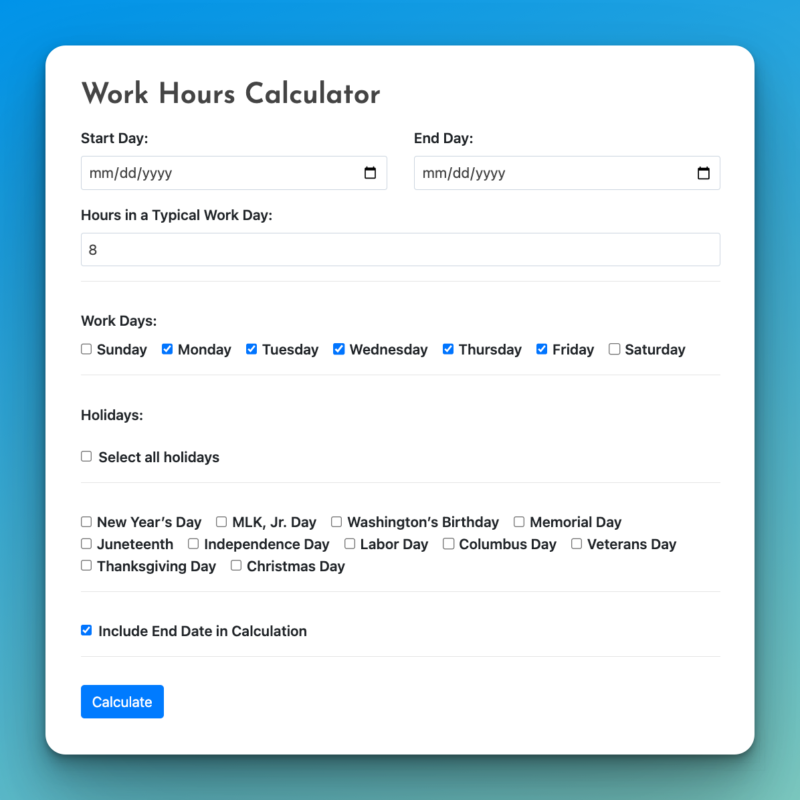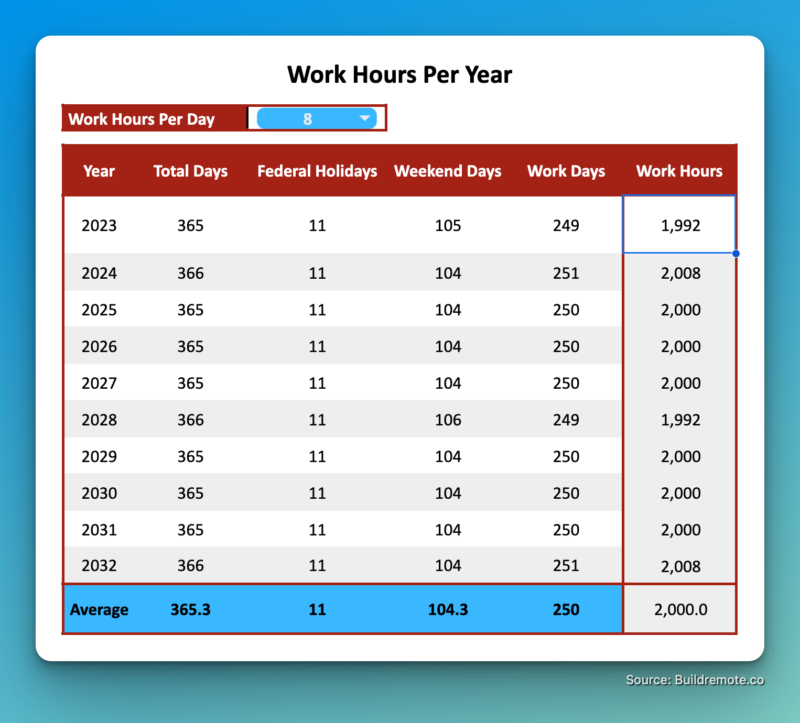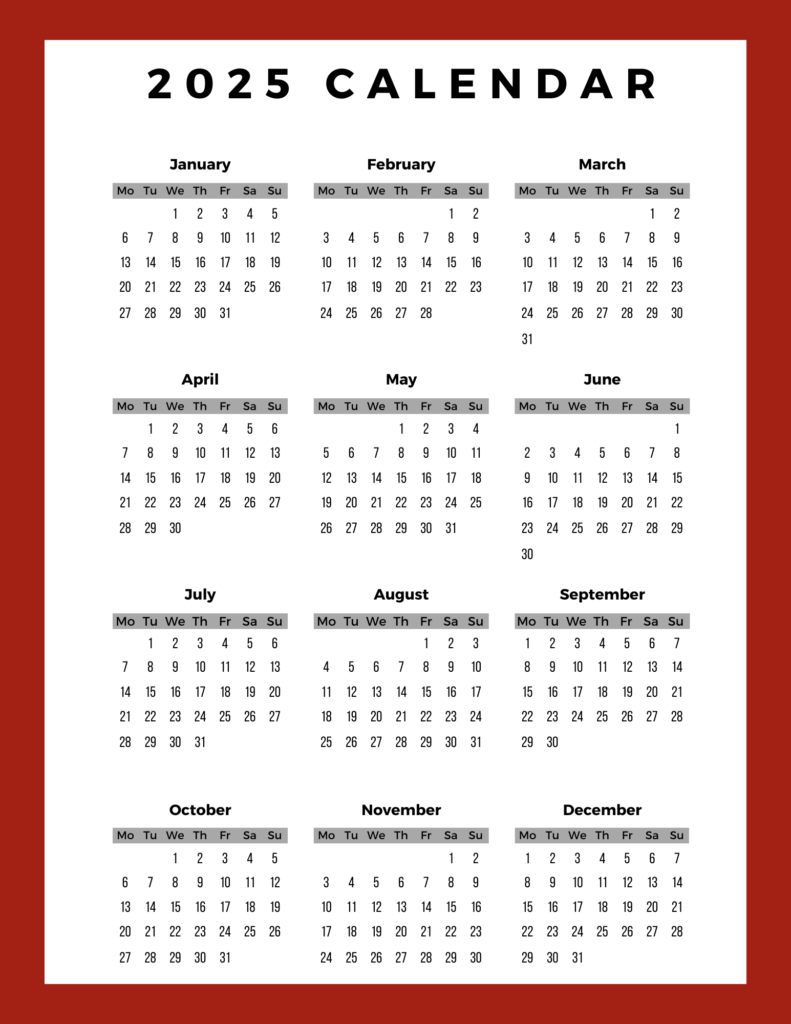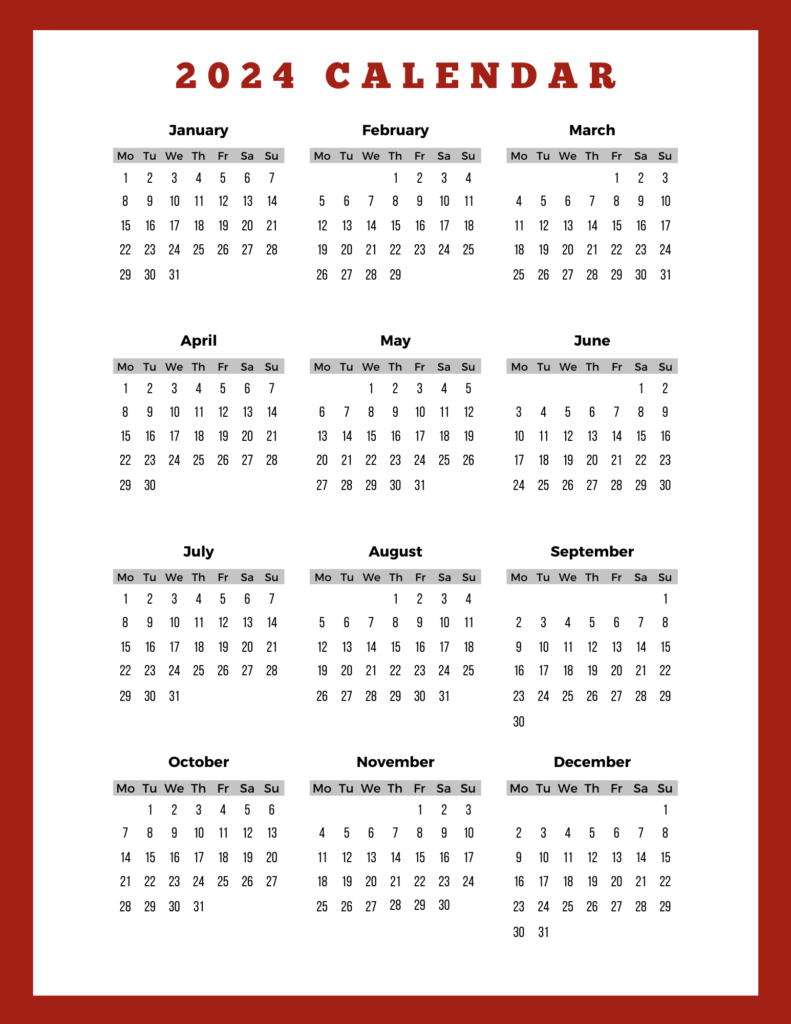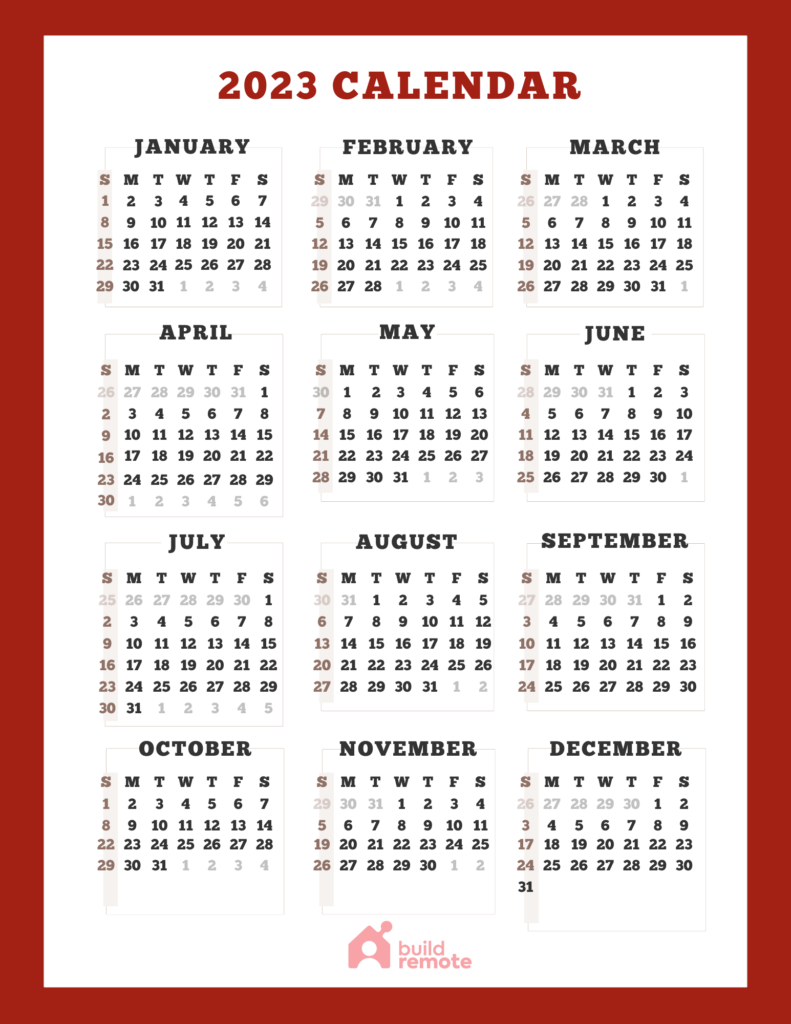How Many Work Hours Are In A Year?
Curious to know how many work hours are in a year? This post has the answers.
You’re planning out your business calendar and need to know how many work hours in a year. Maybe you’re setting work schedules, hours for part-time employees, or company goals by month. In this article, we answer every question we think you might have about the amount of work hours in a year and provide spreadsheets for you to work with on your own.
- How many work hours are in a year? (excluding holidays)
- How many work hours including holidays?
- Work hours by year, 2023-2032
- Work hours calculator
- How to calculate work hours (formula)
How many work hours are in a year (excluding holidays)?
On average, there are 2,000 working hours per year if you look at the current 10-year period (2023-2032) and excluding hours on federal holidays.
We define a workday as a weekday (Monday – Friday) that is not a federal holiday. Then, we assume a typical work day is eight hours and multiply work days by work hours per day to get work hours in a year. We use also work hours, working hours, and business hours interchangeably in this article. Here are the number of work hours in a year for the next decade:
- 2023: 1,992
- 2024: 2,008
- 2025: 2,000
- 2026: 2,000
- 2027: 2,000
- 2028: 1,992
- 2029: 2,000
- 2030: 2,000
- 2031: 2,000
- 2032: 2,008
How many hours are in a work year (including federal holidays)?
On average, there are 2,089.6 work hours per year if you do not include federal holidays (based on the years 2023 – 2032). There are always between 2,080 – 2,112 work hours in a given year using this method.
In this scenario, we are multiplying the number of week days (Monday – Friday) per year by eight hours per day. Here are the work hours per year if you do not factor in federal holidays:
- 2023: 2,080
- 2024: 2,112
- 2025: 2,088
- 2026: 2,088
- 2027: 2,088
- 2028: 2,080
- 2029: 2,088
- 2030: 2,088
- 2031: 2,088
- 2032: 2,096
Work Hours In A Year: 2023-2032
Here is a summary of the working hours and days in a year for the next decade, assuming an eight-hour work day. If you’re on a mobile device, scroll to the right to see all of the data.
| Year | Total Days | Federal Holidays | Weekend Days | Work Days | Work Hours |
|---|---|---|---|---|---|
| 2023 | 365 | 11 | 105 | 249 | 1,992 |
| 2024 | 366 | 11 | 104 | 251 | 2,008 |
| 2025 | 365 | 11 | 104 | 250 | 2,000 |
| 2026 | 365 | 11 | 104 | 250 | 2,000 |
| 2027 | 365 | 11 | 104 | 250 | 2,000 |
| 2028 | 366 | 11 | 106 | 249 | 1,992 |
| 2029 | 365 | 11 | 104 | 250 | 2,000 |
| 2030 | 365 | 11 | 104 | 250 | 2,000 |
| 2031 | 365 | 11 | 104 | 250 | 2,000 |
| 2032 | 366 | 11 | 104 | 251 | 2,008 |
| Average | 365.3 | 11 | 104.3 | 250 | 2,000 |
View the work hours per month for 2024.
Work Hours In A Year Calculator
If you’d like to calculate how many work hours are in a year for your own company (based on your work schedule, holidays, and business hours), use our work hours calculator here.
How To Calculate Work Hours (Formula)
To calculate your own work hours in a year, follow this formula:
First, calculate work days: Work days = Total days in a year – number of company holidays – weekend days
Then, calculate work hours: Work hours = Work days * number of hours per work day
Work Hours Spreadsheet
If you’d rather speed up the process a bit, use this spreadsheet.
- If you’re logged into a Google/Gmail account, you can use the Google Sheets workbook by making a copy (File > Make a copy).
- Or, you can use it in Microsoft Excel by downloading it (File > Download > Microsoft Excel).
Once you have a copy of the workbook, here is how to calculate your own work hours per year.
- Open the “Work Hours Per Year” tab.
- Select the number of work hours your company performs per day (D2).
- Update the “Federal Holidays” column (column D) to your number of paid company holidays per year.
- The number of work hours per year will calculate automatically (column G).
What are the US federal holidays?
There are 11 federal holidays each year, and therefore 88 work hours removed each year to observe those holidays (assuming an eight-hour work day). If you are trying to plan out further into the future, remember that the observed dates of holidays change each year.
Here are the US federal holidays for 2024:
- New Year’s Day: Monday, January 1
- Martin Luther King, Jr. Birthday: Monday, January 15
- President’s Day: Monday, February 19
- Memorial Day: Monday, May 27
- Juneteenth: Wednesday, June 19
- Independence Day: Thursday, July 4
- Labor Day: Monday, September 2
- Columbus Day: Monday, October 14
- Veterans Day: Monday, November 11
- Thanksgiving: Thursday, November 28
- Christmas: Wednesday, December 25
Here are some other popular holidays many companies offer as paid days off:
- Friday after Independence Day (Friday, July 5)
- Friday after Thanksgiving (Friday, November 29)
- Christmas Eve (Tuesday, December 24)
- New Year’s Eve (Tuesday, January 31)
Working Hours Tools & Templates
Want to take some of this data with you? Feel free to download any of these images and datasets for the recent work years. If you choose to use it on your website, please give credit to Buildremote using this article’s website address.
| Source: https://buildremote.co/management/how-many-work-days-in-a-year/ |
Spreadsheet: 2023 – 2032 Work Hours Per Year Dataset
We have created a Google Sheets workbook with a tab for each year from 2023 – 2032 and summary tabs for all years. Within each tab, you’ll find total days, federal holidays, weekend days, work days, and work hours by month. You’ll also see a tab to calculate work hours per year based on your hours and holiday schedule.
To use the spreadsheet, you have two options:
- Log into your Google account, then click “File” and “Make a copy.”
- Download the workbook to Excel by clicking “File” and “Download.”
2025 Work Calendar
⬇️ Download this image | ✏️ Customize in Canva
2024 Work Calendar
2023 Work Calendar
Additional Data Sets
Slice the work calendar data differently:
View the work days and hours per month for 2023, 2024, 2025.
Definitions
Here is how we define each term you see used in the information provided above.
- Work hours per day: Eight hours per day
- Work hours per year: The number of work days (weekdays minus federal holidays) multiplied by work hours per day (eight)
- Weekdays: Monday – Friday
- Work days, working days, business days: A weekday (Monday – Friday) that is not a federal holiday.
- Weekend days: Saturdays and Sundays
- Federal holidays: Paid weekdays off from work for employees of the U. S. federal government
How To Use This Data About Working Hours Per Year
As you plan out goals for the year, having 2,008 working hours versus 1,992 could make a big difference… especially if you are a stable, well-established business. Maybe that 1% difference doesn’t sound like a lot, unless you have a mature business growing or shrinking at just a few percentage points each year.
That’s why it is important to know the number of work hours per year, work days per year, weekdays, weekend days, and holidays in a year. Here are a few ways we imagine people using the data compiled here:
- Set monthly, quarterly, and annual goals: Understand how many working hours, weekdays, holidays, and weekend days fall each month, quarter, and year. With that information, you can adjust your expected goals and returns based on hours you’ll be open and working.
- Prepare your payroll calendar: See the full calendar of days and hours so you know when your 24, 26, or 52 payroll dates will occur throughout the year
- Set your company holidays: Start with the list of 11 federal holidays and when they are observed. Then, add or subtract holidays throughout the calendar to build your company’s paid holiday list.
Why I Built This ResourceBefore I started Buildremote, I ran a fully remote marketing agency. In January of 2020, we decided to implement a four-day work week after a few months of discussion and research. In switching to a four-day week, we reduced from a 36-hour work week to a 32-hour work week… an 11% decrease in work hours overnight. It got me researching and thinking about work hours per week, month, and year. How can we find ways to show our team that we can free them up in other ways, like fewer or shorter meetings? In my research, I didn’t find a good resource for figuring out work hours, so I wrote it myself on Buildremote. I hope you find it useful.
|
We hope you find this article useful. Just so you know, Buildremote may collect a small share of sales from the links on this page to help keep this site running.


